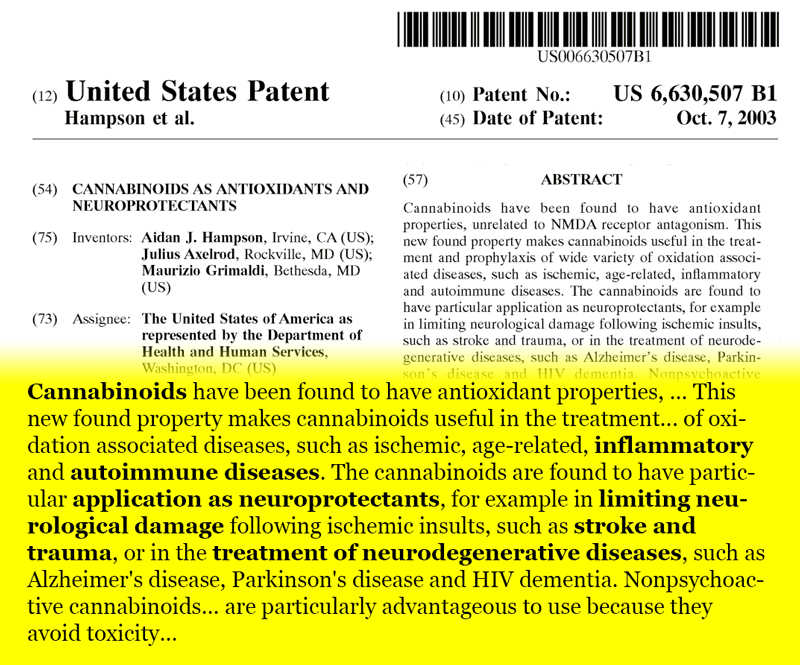

When the Drug Enforcement Administration (DEA) said it would consider rescheduling cannabis, many were hopeful that their life-saving medicine would finally lose its Schedule I status and receive government recognition of its medicinal benefits.
Not only was it not rescheduled, but the head of the DEA apparently had a hell of a time laughing about the prospect of these medicinal qualities.
Rightly so, anti-prohibitionists were outraged and, like any well-organized community, took to social media with hashtags, links to articles like this one and even pictures of the numbers written on their palms next to a “talk to the hand” anecdote.
Read on to find out the truth about what this patent really means because it’s probably not what you think. You don’t have to remember the number, just remember the facts.
1. How the U.S. Got Patent 6630507
Patent 6630507 was granted to the Department of Health and Human Services in 2003.
When the National Institutes of Health (NIH), which operates under this department, uncovers potential innovations or other discoveries, they apply for a patent so that they can control the research and allow others to do testing.
Scientists with the NIH were searching for antioxidant qualities to help in degenerative brain diseases when they applied for the patent in 1999.
2. What the Patent Really Says
You may have heard that the U.S. has a patent on cannabis, but that is only partly correct.
Patent 6630507 only covers some non-psychoactive compounds found in the plant, rather than the whole plant, which means it has nothing to do with tetrahydrocannabinol (THC).
Possibly the most medicinally important compound, cannabidiol (CBD), is mentioned, though, and quite often.
The patent also states, “No signs of toxicity or serious side effects have been observed following chronic administration of cannabidiol to healthy volunteers, even in large acute doses….”
So, basically, the government knows both that certain compounds in cannabis have medicinal properties and that they are not at all harmful for human consumption.
3. The NIH’s Medicinal Expectations for Cannabis
In the abstract alone, scientists express that non-psychoactive cannabinoids act as antioxidants which could aid in the treatment of Alzheimer’s, Parkinson’s and HIV dementia.
They even state that it could be preventative in that these compounds could limit damage caused by stroke and other trauma.
The patent goes on to speculate about the benefits of these compounds in treating glaucoma, seizures and more.
Think of these compounds like plastic wrap or a ziplock, which you would use to cover food you don’t want getting old and dried out, otherwise known as oxidization.
When they say CBD is an antioxidant, they mean it prevents your brain from oxidizing, better known as aging.
4. Why the Patent Doesn’t Make it Legal
The patent only proves the potential for these compounds to aid in degenerative diseases.
The government says it needs to do more research in order to understand long-term effects, proper dosage and individual effects on specific diseases before it can be released to the public.
That’s their reasoning at least, though it does call into question the plant’s Schedule I status, which is reserved for substances known to have zero medical benefits.
The patent expires in 2019, which might make you think the NIH has been working hard to find out more about these compounds, and that’s where licensing comes in.
This is the main reason for the patent; the NIH can make a deal with some other company to continue researching their findings with stipulations. For instance, Kannalife is the sole licensee of patent 6630507.
They have been contracted to research possible effects on treatment for cirrhosis.
The agreement also entitles the NIH to a percentage of royalties once the company starts making money off the patent.
This is an example of a business that wants cannabis to stay illegal for most people so that they can invest in the pharmaceutical opportunities it presents, and the government is helping them do so.
5. Should I Be Up in Arms?
Oh, definitely.
The patent proves that there are at least some medicinal properties to cannabis and that the government has known about it for decades.
Patent 6630507 references 12 other U.S. patents related to cannabis dating back to 1942. The recognition of medicinal qualities in cannabis disqualifies it from its Schedule I ranking.
Additionally, this juxtaposition between the patent and the DEA’s ruling shows there is a disconnect between our governmental departments.
So, go ahead and tell the DEA how you feel.
Whether you prefer to give them the hand or the finger, bringing awareness to this anomaly shows the government that we know they know the truth.
Source: PROHBTD
more recommended stories
 Pelosi Statement on President Biden’s Historic Student Debt Relief
Pelosi Statement on President Biden’s Historic Student Debt ReliefAUGUST 24, 2022 PRESS RELEASE San.
 NY Times Reveals Racist Double-Standard in Mayra Flores Smear
NY Times Reveals Racist Double-Standard in Mayra Flores SmearByJacob Bruns July 7, 2022 NY.
 World Health Organization Issues New Guidelines On Abortion Including Ending All Time Limits Restricting Abortions
World Health Organization Issues New Guidelines On Abortion Including Ending All Time Limits Restricting AbortionsAccess to safe abortion critical for.
 Polk County First Confirmed Case Of Rabies In 2022
Polk County First Confirmed Case Of Rabies In 2022MAR 3, 2022 Media Contact: Brian Bruchey,.
 Judge Blocks Effort To Keep Cawthorn Off NC Ballots
Judge Blocks Effort To Keep Cawthorn Off NC BallotsUpdated March 4, 2022 2:00 p.m..
 Florida Legislature Passes Bill Banning Abortions After 15 Weeks
Florida Legislature Passes Bill Banning Abortions After 15 WeeksPresident Office — Press Release FOR.
